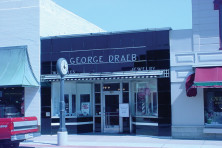Astronomical Event of the Century
- Share
- Tweet
- Pin
- Share
by the Door Peninsula Astronomical Society
We all know what happened 50 years ago: Apollo 11 made the first manned moon landing on July 20, 1969. But what event in July 1994 did several publications that year dub the “astronomical event of the century”? It was the fascinating impact of fragments of Comet Shoemaker-Levy 9 with the giant gas planet, Jupiter.
David H. Levy, Eugene “Gene” Shoemaker and Carolyn Shoemaker were comet hunters who collaborated on the discovery of several comets. On March 24, 1993, using the 18-inch Schmidt telescope at Palomar Observatory in California, they discovered a comet that was given the official name of Comet Shoemaker-Levy 9 (because other comet discoveries had also been attributed to them). Continued observation revealed that the comet was fragmented and that, given the orbit of the fragments, they would strike Jupiter the following July.
The Daily Comet reported that “at about 5 pm PST on March 25, 1993, David Levy, Eugene Shoemaker and Carolyn Shoemaker asked Jim Scotti at Kitt Peak Observatory near Tucson, Arizona, to confirm their codiscovery of a new comet with the Spacewatch 36-inch telescope.
‘Do we have a comet?’ David Levy asked. The response: ‘Boy, do you ever have a comet!’ Jim Scotti reported seeing at least five separate comet pieces side by side, with additional comet matter between them.”
Never before had astronomers directly observed a collision of bodies in the solar system outside of Earth. The Hubble Space Telescope (HST) was recruited to document the events, but the HST entered safe mode unexpectedly after, it was determined, a memory board had failed. Then it went into a deeper sleep mode, suggesting problems with two gyros that position and maintain the telescope’s orientation. But all six gyros had recently been replaced, and hardware monitoring indicated that they were all working properly. Fortunately, resetting a counter in the software could solve the problem, and that was done by July 9 – in time for HST to join other telescopes around the world in watching for the predicted collision event.
On May 19, 1993, Syuichi Nakano computed an orbit that indicated that the comet had passed close to Jupiter in 1992, and the orbit would cross closer to the center of Jupiter than its radius. In other words, it would impact Jupiter. This orbit was especially fascinating in that most comets orbit the sun, not one of the planets.
As “dirty ice balls” or “icy dirt balls,” comets tend to be quite fragile. Based on the computed orbit, Shoemaker-Levy 9 passed within 15,500 miles of Jupiter. That would be within the Roche limit: the area within which the difference between the gravity on Jupiter’s far side and the gravity on its near side would cause an object to break apart. That’s a rather extreme example of tidal forces.
Initially it would be like a disorganized cluster of fragments that would, over a period of about two hours, line up in a row, pointing to and away from Jupiter. As the fragments separated, they could be imaged as a string of bright objects.
Professional and amateur astronomers alike pointed their telescopes at Jupiter from July 16 to 24, 1994. The first impacts were on the side of Jupiter not facing earth, but soon the rotation of the planet brought into view the impacts’ scars. Later, one of the 20-some fragments, labeled Fragment G, encountered Jupiter’s thin atmosphere. The shock wave produced an extremely brilliant flash, and its impact scar was larger than our entire planet.
Since the S-L 9 impact, there has been evidence of others, and today there may well be disagreement as to what the “astronomical event of the century” really was. This event was predicted and captured in many images, and it served as the inspiration for movies. Impact residuals were detectable for more than two years. Astronomers gained information about the Jovian atmosphere and winds by studying the impact sites. And Gene Shoemaker’s lifelong dream was fulfilled.


